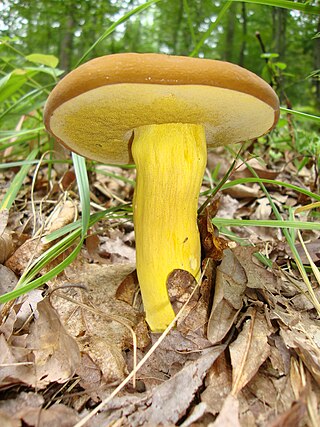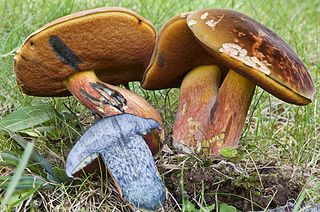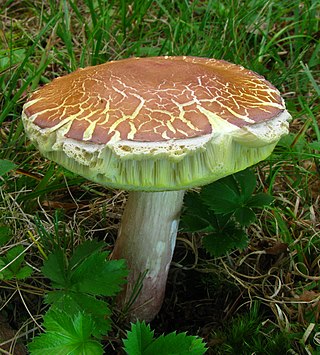
Baorangia bicolor, also known as the two-colored bolete or red and yellow bolete after its two-tone coloring scheme of red and yellow, is an edible fungus in the genus Baorangia. It inhabits most of eastern North America, primarily east of the Rocky Mountains and in season during the summer and fall months but can be found across the globe in China and Nepal. Its fruit body, the mushroom, is classed as medium or large in size, which helps distinguish it from the many similar appearing species that have a smaller stature. A deep blue/indigo bruising of the pore surface and a less dramatic bruising coloration change in the stem over a period of several minutes are identifying characteristics that distinguish it from the similar poisonous species Boletus sensibilis. There are two variations of this species, variety borealis and variety subreticulatus, and several other similar species of fungi are not poisonous.

Butyriboletus appendiculatus is an edible pored mushroom that grows under oaks and other broad leaved trees such as beech. It is commonly known as the butter bolete. It often grows in large colonies beneath the oak trees, and is frequently found cohabiting with old oaks in ancient woodland. It is relatively rare in Britain. Its stipe and pores are often bright yellow and its flesh stains bright blue when cut or bruised.

Boletus sensibilis is a species of fungus in the family Boletaceae. The species was first described scientifically by American mycologist Charles Horton Peck in 1879. This species is very similar to two other red boletes, Baorangia bicolor and Boletus pseudosensibilis.

Charles Christopher Frost was an American mycologist. He described several species of fungi from the New England area of the United States. In one paper, Frost described 22 new species of boletes, and he was later credited with the discovery of three additional species. His personal herbarium of specimens were given to the University of Vermont in 1902. Portions of his collection today are distributed between the Farlow Herbarium at Harvard University, the New York State Museum, the Bell Museum of Natural History, and the Buffalo Museum of Science.

Tylopilus tabacinus is a species of bolete fungus in the family Boletaceae. It is characterized by a tawny-brown cap measuring up to 17.5 cm (6.9 in) in diameter, and a reticulated stem up to 16.5 cm (6.5 in) long by 6 cm (2.4 in) thick. A characteristic microscopic feature is the distinctive crystalline substance encrusted on the hyphae in the surface of the cap. The species is known from the eastern United States from Florida north to Rhode Island, and west to Mississippi, and from eastern Mexico. It is a mycorrhizal species, and associates with oak and beech trees.

Tylopilus alboater, called the black velvet bolete, by some, is a bolete fungus in the family Boletaceae. The species is found in North America east of the Rocky Mountains, and in eastern Asia, including China, Japan, Taiwan, and Thailand. A mycorrhizal species, it grows solitarily, scattered, or in groups on the ground usually under deciduous trees, particularly oak, although it has been recorded from deciduous, coniferous, and mixed forests.

Boletus auripes, commonly known as the butter-foot bolete, is a species of bolete fungus in the family Boletaceae. First described from New York in 1898, the fungus is found in eastern Asia, Central America, and eastern North America from Canada to Florida. It is a mycorrhizal species and typically grows in association with oak and beech trees.

Xerocomus illudens is a species of bolete fungus in the family Boletaceae. Described as new to science in 1898, it is found in Asia and North America, where it grows in a mycorrhizal association with oak.

Boletus subvelutipes, commonly known as the red-mouth bolete, is a bolete fungus in the family Boletaceae. It is found in Asia and North America, where it fruits on the ground in a mycorrhizal association with both deciduous and coniferous trees. Its fruit bodies (mushrooms) have a brown to reddish-brown cap, bright yellow cap flesh, and a stem covered by furfuraceous to punctate ornamentation and dark red hairs at the base. Its flesh instantly stains blue when cut, but slowly fades to white. The fruit bodies are poisonous, and produce symptoms of gastrointestinal distress if consumed.

Boletus vermiculosus is a species of bolete fungus in the family Boletaceae. Found in North America, it was described as new to science in 1872 by mycologist Charles Horton Peck.
Boletus glabellus is a fungus of the genus Boletus native to North America. It was described in 1888 from species collected near Menands, New York by American mycologist Charles Horton Peck.

Boletus variipes is a species of mycorrhizal bolete fungus in the family Boletaceae, native to North America. It was originally described by American mycologist Charles Horton Peck in 1888.

Leccinellum albellum is a species of bolete fungus in the family Boletaceae. Originally described by Charles Horton Peck as a species of Boletus, and, after 1945, usually considered a species of Leccinum, it was transferred to the newly created genus Leccinellum in 2003. The bolete was reported from a Mexican beech forest in Hidalgo, Mexico in 2010.

Boletus morrisii is a fungus of the genus Boletus native to North America. It was described in 1909 by mycologist Charles Horton Peck.

Austroboletus gracilis is a species of bolete fungus in the family Boletaceae. Originally described as Boletus gracilis by Charles Horton Peck in 1872, it was transferred to the genus Austroboletus by Carl B. Wolfe in 1979.

Hemileccinum hortonii is a fungus of the genus Hemileccinum native to the United States. First described as variety corrugis of Boletus subglabripes by Charles Horton Peck in 1897, it was given its current name in 1971 by mycologists Alexander H. Smith and Harry Delbert Thiers. The species is edible.

Suillus punctipes, commonly known as the spicy suillus, is a bolete fungus in the family Suillaceae.

Boletus separans is a species of bolete fungus in the family Boletaceae. It was described as new to science in 1873 by American mycologist Charles Horton Peck. In 1998, Roy Halling and Ernst Both transferred the bolete to the genus Xanthoconium. Molecular phylogenetic analysis published in 2013 shows that it is more closely related to Boletussensu stricto than to Xanthoconium.

Aureoboletus auriporus, is a species of bolete fungus in the family Boletaceae that is found in Europe and North America. It was originally described in 1872 by American mycologist Charles Horton Peck, who called it Boletus auriporus. Zdenek Pouzar transferred it to the genus Aureoboletus in 1957.

Boletus nobilis, the noble bolete, is a species of edible basidiomycete mushroom of the genus Boletus found in eastern United States. Morphologically close to Boletus edulis, it is distinguished by an elongated stem, a beige skin and white pores, even when old.



















